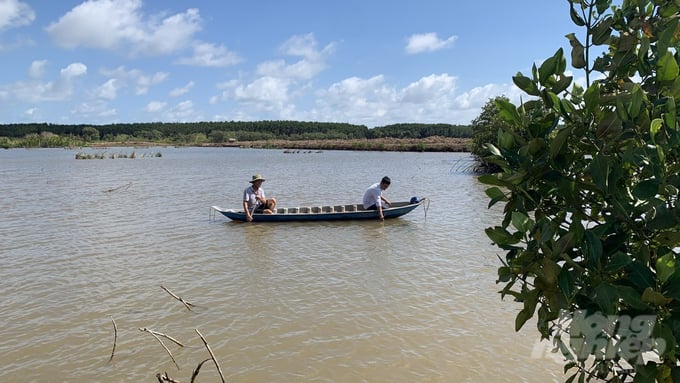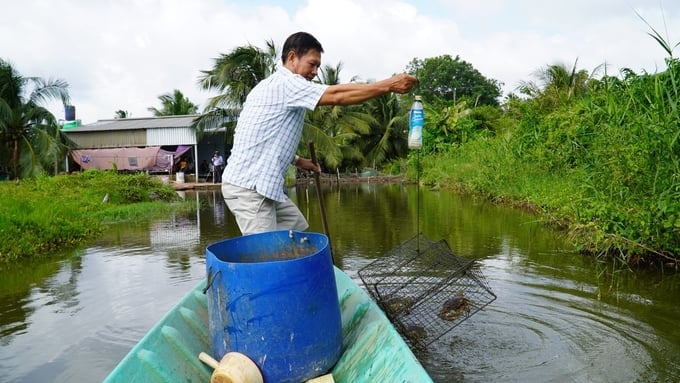May 29, 2025 | 13:40 GMT +7
May 29, 2025 | 13:40 GMT +7
Hotline: 0913.378.918
May 29, 2025 | 13:40 GMT +7
Hotline: 0913.378.918

Farmers in Duyen Hai District, Tra Vinh Province are developing aquaculture under forest canopy. Photo: Ho Thao.
According to residents in the coastal regions of Tra Vinh Province, local farmers have implemented the model of shrimp farming under mangrove forest canopy, primarily in Duyen Hai District, for several years.
During the first few years of implementation, local households adopting this model reported significant profits and economic returns; however, only a small number recognized that the success of this model was dependent on the support of the forest ecosystem. Conversely, other households mistakenly believed that the expanding roots of the trees were encroaching on the shrimp farming areas, prompting them to clear the forests and expand their ponds.
As a result, local shrimp farmers continuously faced failures, and many families plunged into substantial debts.
With support from the local government and lessons learned from experience, the residents of Tra Vinh Province gradually realized that the lack of forest cover was the cause of increased disease susceptibility in their aquatic stock. Subsequently, they began collaborating with relevant agencies to replant and restore forests.
Nguyen Chuc Linh, an experienced shrimp farmer from Phuoc Thien Hamlet, Dong Hai Commune, shared: "In the past, the majority of shrimp farms used industrial models with very low survival rates, at around 10 to 15%, due to thermal stress. After I planted mangrove trees in the ponds to provide shade and shelter for the shrimp, disease risks have significantly diminished. The success rate of this model has reached over 80%, which is significantly higher than that of traditional shrimp farming."
Farmer Nguyen Chuc Linh stocks 40,000 to 45,000 shrimp and 5,000 to 10,000 crabs over his 4-hectare farming area every year, achieving an average profit of 120 million VND per hectare per year, including 20 million VND from crabs. Despite the lower income compared to that of industrial farming, the shrimp-forest model provides long-term stability.
Linh emphasized that farmers must adhere to the established stocking schedule and select high-quality shrimp stock to ensure high productivity in extensive shrimp farming under forest canopy. His family typically stocks in four batches every year, with each consisting of approximately 10,000 shrimp. Notably, during the rainy season, when water temperature and salinity fluctuate, Linh switches to crab farming in order to maintain a stable income.
Linh noted that shrimp farming under the forest canopy not only requires less maintenance but also reduces feed costs by utilizing natural microorganisms in the water, which boosts the shrimp's health and disease resistance. He also values the model for its sustainability and environmental friendliness.
"Local farmers will be eager to participate in a model of aquaculture under the forest canopy that follows a low-emission process for carbon credit utilization. We are ready to participate as soon as the district and province implement the planning and establish pilot models," Linh commented.

Farmers harvesting crabs reared under forest canopy. Photo: Ho Thao.
According to Tra Vinh Province's Department of Agriculture and Rural Development, the Department is requesting approximately 5 billion VND in funding from the Provincial People's Committee to conduct surveys and update the province's forest area; and to hire consultants for their participation in the carbon market.
Le Quang Rang, Deputy Director of the Tra Vinh Province's Department of Agriculture and Rural Development, stated that with a total forest area of over 9,000 hectares, including more than 4,000 hectares of community-planted and managed forest for integrated shrimp farming, the province houses significant potential for participating in the carbon market.
This model not only helps absorb carbon and reduce greenhouse gas emissions, but also provides additional income for shrimp farmers through the sale of carbon credits. However, the shift towards low-emission aquaculture also requires the involvement of specialized sectors.
In addition to participating in the pilot project for one million hectares of high-quality rice, the province is undertaking a scientific and technological task titled "Developing a spatial distribution map, estimating carbon and CO2 absorption capacity in coconut biomass in Tra Vinh Province." Consequently, Tra Vinh also seeks to enter the carbon market with this crop in the near future.
The Shrimp Summit was held in India between late June and early July 2024. The Center for Responsible Seafood (TCRS) is responsible for organizing this annual event. The summit saw the participation of over 500 speakers and industry leaders from around the world.
At this summit, Viet Uc Group, which represents the Vietnam's shrimp industry, presented the "Sustainable Shrimp Farming and Production Value Chain," which has helped to increase the visibility and prominence of Vietnamese shrimp in the international market.
Translated by Nguyen Hai Long
/2025/05/25/4127-3-073637_820.jpg)
(VAN) Thanks to the promotion from an FAO-implemented project, vegetable production in greenhouses in Moc Chau has seen strong development, from 1.5 hectares in 2021 to nearly 50 hectares in 2024.

(VAN) FAO has recently supported USD 140,000 to implement the project 'Risk mitigation human-animal interface risks through disease control initiatives in pig farming.'

(VAN) The People's Committee of Tra Vinh province has approved an adjustment to the investment policy for the Green Hydrogen Plant project, increasing its area to approximately 52.76 hectares.
![Reducing emissions from rice fields: [2] Farmers’ commitment to the soil](https://t.ex-cdn.com/nongnghiepmoitruong.vn/608w/files/news/2025/05/05/dsc08881jpg-nongnghiep-140632.jpg)
(VAN) Clean rice cultivation model in Thuong Tan commune, Bac Tan Uyen district, is assisting local residents in achieving sustainable agriculture by substantially reducing costs, increasing productivity, and protecting the environment.

(VAN) At the conference to disseminate Resolution No. 68, AgriS introduced its digital agricultural ecosystem and reaffirmed its commitment to accompanying the Government in promoting private sector development and sustainable agriculture.

(VAN) 'Blue Ocean - Blue Foods' initiative is designed to restore marine ecosystems and establish sustainable livelihoods for local communities by cultivating a minimum of 1,000 hectares of cottonii seaweed in the first three years.
/2025/05/21/4642-3-112707_603.jpg)
(VAN) The V-SCOPE project has made direct contributions to three out of six pillars of the Comprehensive Strategic Partnership between Vietnam and Australia.